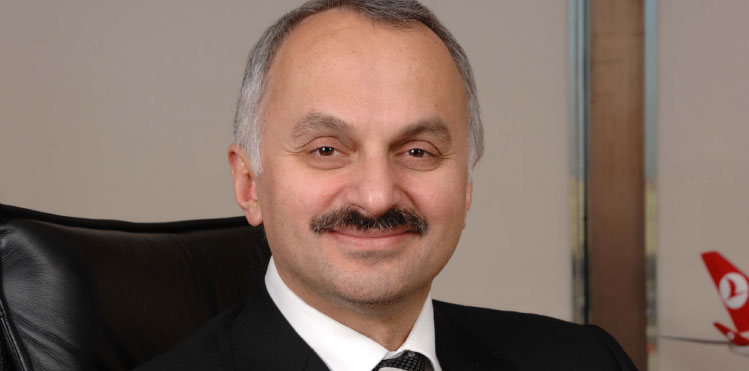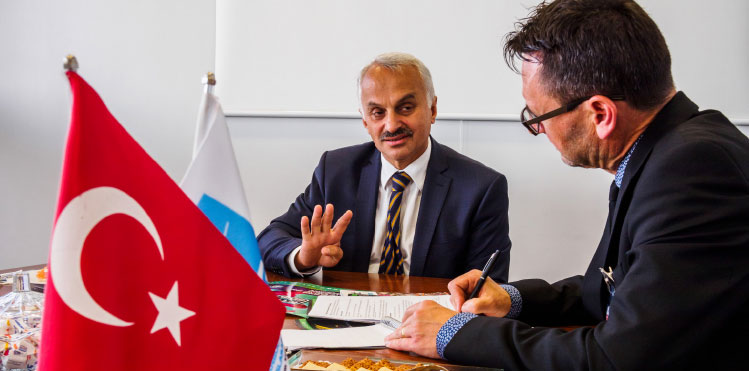
Kotil: “We’re at Sabiha Gökçen to build a business, a stand-alone airline, we’ll have 40+ aircraft here next year, then later we’ll have 100, and Sabiha Gökçen will reach 50 million passengers.”
An interview with Dr Temel Kotil, General Manager and CEO, Turkish Airlines, President, Association of European Airlines. By Paul Hogan.
Few initially took Dr Kotil totally seriously when, soon after his appointment as CEO in 2003, he began saying he was setting about: “Turning Turkish Airlines into the largest airline on Earth.”
But the fact of the matter is that the Star Alliance carrier has been the fastest-growing full service airline in Europe for a decade, adopting a unique hub and spoke strategy which cannot easily be copied by airlines to the north or south. As a result, it has contributed most of the rocketing growth which has taken Istanbul Atatürk Airport from an unremarkable slot in the traffic tables in the 1990s, to overtake Amsterdam Schiphol for fourth place last year, and to now threaten displacement of Frankfurt Airport from third-place in Europe in 2015.
Istanbul: Overtaking Heathrow’s hub
If Istanbul Atatürk were to continue to grow at 9% (as it has in 2015) and for London Heathrow to grow by the same 2% it is achieving (bearing in mind that the earliest a third runway will be built will be 2025), then Istanbul will overtake Heathrow in just three years, or exactly about the time Istanbul New Airport, the €10.2 billion mega-hub, is set to open. However, because of constraint at Istanbul Atatürk, it is possible that Turkish Airlines’ growth could be squeezed, reducing this growth pace. But even then, it does not seem that the assumption of Istanbul having ‘Europe’s largest airport’ will be delayed much beyond 2020.
Of course Turkish Airlines’ ambitions are expected to be entirely served by being the primary customer of Istanbul New Airport when it opens in 2018, and which unsurprisingly Dr Kotil puts in the same “largest on Earth” category as he does his own airline: “The world used to be focused on Northern Europe and America. In this century, it’s our turn.”
Indeed İGA Havalimanı İşletmesi A.Ş (İGA), the five-member consortium building the airport, maintains the same position, claiming that they are building a brand to rival Changi: “The most important hub between New York and Shanghai,” a statement which clearly overlooks the hubs of the Middle East Big Three (MEB3 = Emirates at Dubai, Etihad at Abu Dhabi, and Qatar Airways at Doha).
Kotil agrees that there are some competitive parallels with the MEB3 – notably the clear government support for the role of air transport in both the Turkish and Gulf economies, and how this translates into active support of the objectives of the airline(s), the airport(s), and the fundamental importance of tourism.
But the comparisons end there: Istanbul has a radically different place on the Southern tip of Europe making it much closer to its most important sources of feed. This famously allows Turkish Airlines services to use widebodies to steal feed from European hubs, and larger airports, but crucially to deploy its army of 737-800 single-aisle aircraft to a plethora of potentially hundreds of smaller airports of the size of Gothenburg and Friedrichshafen – airports which cannot viably be exploited for feed by Emirates widebodies.
The genuine success of this hub means that well over 50% of Turkish Airlines’ traffic at Istanbul Atatürk Airport is now transfer. However, Kotil also stresses that Istanbul – and Turkey – also have a much bigger O&D market than Middle East and other hub cities. He points out that Istanbul (pop. 14 million) and Moscow (12 million) are Europe’s “only true mega cities with populations rivalling those in Asia.” Kotil says this means the potential volume for O&D is “sky-high” compared to super-luxurious Dubai (pop. 2.1 million), and certainly just-overtaken Frankfurt (0.7 million), and even Europe’s great visitor magnets of London (8.5 million), and Paris (2.3 million).
Kotil enthuses: “Istanbul is an excellent mega city. It is not an eastern city, nor a western city, it is multi-cultural.” The number of tourist visits to Istanbul has trebled this century from four million to 12 million. With the Turkish economy four times bigger than it was in 2000, business and leisure passengers have plenty of reason to visit Istanbul and Turkey (pop. 75 million). Turkish Airlines is assisting this effect, even with the transfer passengers – those with a wait of six hours or more can now make the most of a free tour of Istanbul, turning those using its hub from people changing planes into real tourist dollar visitors to Turkey.

Dr Kotil puts the €10.2 billion Istanbul New Airport, opening in 2018, in the same “largest on Earth” category as he does his own airline: “The world used to be focused on Northern Europe and America. In this century, it’s our turn.”
Africa surges; Russia underserved
Besides Europe, key feed markets increasingly include African cities, where Turkish Airlines has just announced its 45th destination – far more than any other foreign carrier. Indeed Turkish Airlines’ seems to have continued a taste for the single-aisle strategy in this market – even though MEB3 carriers would have an operational and cost advantage with 737/A320 types.
While Turkey’s membership of the EU now seems indefinitely stalled, in air transport terms Turkish Airlines’ access to the EU is more or less open (and reciprocated). However, elsewhere in Europe, especially the states of Russia and the Eurasian Economic Union (the Russian-led successor to the CIS) Turkish Airlines’ potential seems to have been curbed. Indeed the 45 African destinations stands in stark contrast to the 10 current destinations in industrialised Russia, indicating a massive market which is being held back.
Russian tourists are keen on visa-free holidays to Turkey but, due to restrictive bilateral agreements governing air services, they rely heavily on charter flights which generate good traffic statistics for Turkey’s airports, but obviously not the feed Turkish Airlines desires. “We obviously want to serve Russia more, and while there have been changes to the markets because of the Ukrainian situation, demand has compensated for the drops – Russia is an important opportunity, but it is difficult… it is going to be step-by-step… nothing is impossible… always possible!”
Istanbul Sabiha Gökçen: “We’re here to build a business”
So, with the Istanbul mega hub rising out of the ground, is Turkish Airlines’ need to start a base at Sabiha Gökçen in 2013 a big distraction which dilutes the strength of the fortress? “Sabiha Gökçen has its own catchment and that’s going to be extended by new high speed rail which will feed into other cities as far away as the Dardanelles, Bursa and Izmir… Turkey is building the best regional infrastructure in support of Sabiha Gökçen.”
Kotil explains that one of the key functions of the Turkish Airlines’ Sabiha Gökçen base is also positioned as a second project to link Europe to the Middle East. “We’re at Sabiha Gökçen to build a business, a stand-alone airline, we’ll have 40+ aircraft here next year, then later we’ll have 100, and Sabiha Gökçen will reach 50 million passengers.” Consequently, Turkish Airlines will play a big role in the next chapter of Sabiha Gökçen’s rise from insignificance, 10 years ago, to become Istanbul’s robust second airport approaching 24 million passengers, with the expectation that a second runway will be ready within two years, giving Istanbul an eight-runway system in the medium-term.
Kotil also claims the advent of the new airport will encourage expansion of his traffic over the city in other ways: “Many Asian airlines will increase their routes and frequencies to both of Istanbul’s airports. Our message to other airlines, whether code sharers or Star Alliance is: Fly to Turkey more!”







